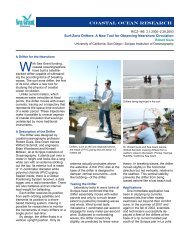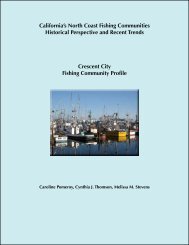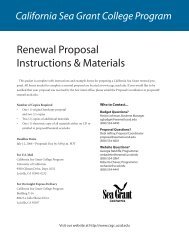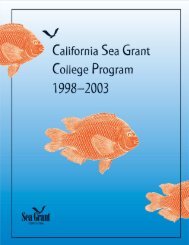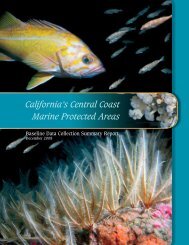2001â2002 - California Sea Grant - UC San Diego
2001â2002 - California Sea Grant - UC San Diego
2001â2002 - California Sea Grant - UC San Diego
You also want an ePaper? Increase the reach of your titles
YUMPU automatically turns print PDFs into web optimized ePapers that Google loves.
<strong>San</strong>ta Cruz & Monterey<br />
Counties<br />
RICHARD M. STARR<br />
<strong>Sea</strong> <strong>Grant</strong> Extension Program<br />
Moss Landing Marine Laboratories<br />
8272 Moss Landing Road<br />
Moss Landing, <strong>California</strong> 95039<br />
starr@mlml.calstate.edu<br />
Phone: (831) 771-4442<br />
Fax: (831) 632-4441<br />
To assist fishery managers,<br />
the Monterey Bay National<br />
Marine <strong>San</strong>ctuary asked <strong>Sea</strong><br />
<strong>Grant</strong> Marine Advisor Rick<br />
Starr and colleagues to compile<br />
data on the status of fisheries in<br />
the region. Their new book,<br />
“Trends in Fisheries and Fishery<br />
Resources Associated with the<br />
Monterey Bay National Marine<br />
<strong>San</strong>ctuary from 1981–2000,”<br />
was published in 2002. It<br />
summarizes the technical<br />
concepts and information typically used to estimate fishery population<br />
sizes, provides brief descriptions of the types of fisheries operating in each<br />
habitat type, and summarizes fishery management options.<br />
They found that more than 1,200 commercial vessels annually fish<br />
within the <strong>San</strong>ctuary, about a 40% decline since the 1980s. Total catches<br />
have increased as commercial fishers have targeted abundant pelagic<br />
species such as Pacific sardine and squid, but landings of all other species<br />
combined have greatly decreased. Catches and effort in recreational<br />
fisheries since the late 1980s have slighted declined, but recreational<br />
Photo: Richard M. Starr, <strong>California</strong> <strong>Sea</strong> <strong>Grant</strong> Extension Program<br />
harvests still exceed commercial harvests for<br />
many nearshore species.<br />
In another fisheries project in 2002, Starr<br />
reviewed studies of the effectiveness of four<br />
fully protected marine reserves in <strong>California</strong>:<br />
three in the Monterey Bay National Marine<br />
<strong>San</strong>ctuary (Hopkins Marine Life Refuge, Point<br />
Lobos Ecological Reserve, Big Creek Ecological<br />
Reserve), and one in the Channel Islands<br />
National Marine <strong>San</strong>ctuary (the natural area<br />
on the north side of East Anacapa Island). The<br />
authors compared the reserve effects apparent<br />
in the existing reserves with effects predicted<br />
by the scientific literature, and a National<br />
31



